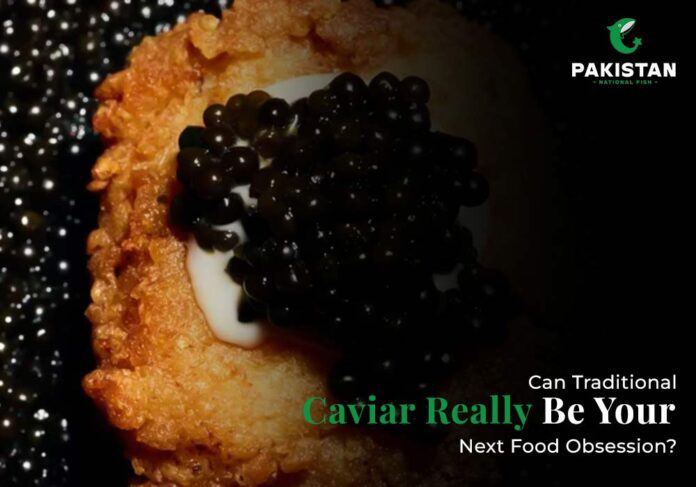Ever nibbled on tiny, glistening beads that pop with ocean flavor, like tasting small perch fish eggs for the first time? That’s caviar—a delicacy that feels like a luxurious secret but is surprisingly approachable. Whether you’re eyeing it at a fancy party or curious about trying it at home, caviar is more than just a status symbol. It’s a burst of flavor, history, and craftsmanship, with a wide range of caviar varieties that cater to every palate and occasion.
Let’s dive into the world of caviar for beginners, exploring where to find it, how to buy it, what it tastes like, and why some jars cost more than a car payment. Ready to become a caviar convert? Let’s go!
What Exactly Is Caviar?
Caviar is salt-cured fish eggs, or roe, from sturgeon (family Acipenseridae). These ancient fish, swimming since dinosaur days, produce the tiny pearls we call caviar. Unlike other fish roe—like salmon or tobiko—only sturgeon roe earns the “caviar” title, per strict definitions. It’s a delicacy prized for its unique texture and flavor, often served chilled as a garnish or spread.
- Origin: Mostly from the Caspian and Black Seas, but now farmed globally.
- Process: Eggs are gently extracted, rinsed, salted (malossol means “little salt”), and aged for weeks to months.
- Why it’s special: Rarity, labor-intensive harvesting, and that satisfying pop make it a luxury.
What Are the Different Types of Caviar?
Type | Scientific Name | Description |
Beluga | Huso huso | Large, soft eggs with a creamy, buttery taste. Rare and pricey due to endangered status. |
Ossetra (Osetra) | Acipenser gueldenstaedtii | Medium-sized eggs, nutty and complex, with a firm texture. |
Sevruga | Acipenser stellatus | Small, intense eggs with a bold, briny flavor. |
Kaluga | Huso dauricus | Large, creamy eggs, similar to Beluga but more sustainable. |
White Sturgeon | Acipenser transmontanus | Buttery, mild eggs, often from US farms. |
Hackleback | Scaphirhynchus platorynchus | Small, nutty eggs from wild US sturgeon—affordable yet flavorful. |
Paddlefish | Polyodon spathula | Earthy, silky roe, not true caviar but a budget-friendly substitute. |
Salmon Roe | Oncorhynchus spp. | Bright orange, fishy eggs, often called “red caviar.” |
Tobiko | Clupeidae spp. | Tiny, crunchy flying fish roe, common in sushi. |
Where Can You Buy Caviar in the US?
Caviar is more accessible than you might think. From grocery stores to specialty shops, here’s where to find it:
- Whole Foods Market: Offers caviar whole foods market staples like White Sturgeon and Salmon Roe. Their responsibly farmed options are great for beginners. Look for brands like Tsar Nicoulai or Caviar Russe.
- Specialty Retail: Petrossian (New York and online) and Russ & Daughters (New York) are gold standards for best caviar. They carry premium Ossetra and Kaluga.
- Local Producers: Carolina caviar, like that from The Caviar Farm in North Carolina, offers buttery, golden-hued options.
- Big Box Stores: Costco sells affordable ossetra and white sturgeon in bulk for parties.
- Restaurants: High-end spots like Le Bernardin (New York) or Gotham (Miami) serve caviar dishes, perfect for tasting before buying.
Tip: Always check the source. Reputable sellers provide details on origin, species, and farming practices.
How Do You Buy Caviar Online Safely?
Buying caviar online is convenient but requires caution. Here’s how to do it right:
- Choose Trusted Retailers: Stick to established names like Marky’s, Petrossian, or Caviar Russe. They guarantee quality and freshness.
- Check Labels: Look for species (e.g., Acipenser baerii for Siberian sturgeon), harvest year, and “malossol” for low salt.
- Read Reviews: Customer feedback on sites like The Caviar Co. or Fulton Fish Market reveals taste and texture insights.
- Storage Info: Ensure the seller ships with ice packs in a Styrofoam cooler for overnight delivery.
- Start Small: A 1 oz of caviar serves two people. Try a taster pot (10g) from brands like Imperial Caviar for $20–$50.
Magic Tip: Look for sampler packs (e.g., Caviar Club’s Ossetra and Kaluga duo) to compare flavors without breaking the bank.
Why Is Some Caviar So Expensive?
Caviar prices range from $20 for cheap caviar like salmon roe to $5,000 for a kilo of Special Reserve Ossetra. Why the gap?
- Rarity: Beluga sturgeon take 20+ years to produce eggs, and overfishing has made them endangered.
- Labor: Harvesting eggs via C-section or massage is delicate and skilled work.
- Farming: Sustainable farms in China, Israel, or California invest heavily in clean water and controlled diets.
- Quality: Larger, firmer eggs with nuanced flavors (like Ossetra) cost more than smaller, saltier ones (like lumpfish).
- Origin: Chinese Kaluga Queen dominates global production, but rare Iranian Almas can hit $34,000 per kilo.
Cheap Caviar Options:
- Paddlefish ($16–$28/oz): Bold and earthy, great for parties.
- Hackleback ($35–$50/oz): Nutty and sweet, a US favorite.
Tobiko ($15/oz): Crunchy and mild, perfect for sushi.
What Does Caviar Taste Like?
Caviar’s flavor is a dance of the sea—salty, briny, and savory with umami depth. Each variety has its own personality:
- Beluga: Creamy, buttery, with a mild sea breeze.
- Ossetra: Nutty, earthy, with a lingering mineral finish.
- Sevruga: Intense, briny, like a salty ocean wave.
- Kaluga: Rich, creamy, with a subtle sweetness.
- White Sturgeon: Smooth, buttery, with a clean aftertaste.
- Salmon Roe: Fishy, bold, with a juicy pop.
The texture? Tiny beads that burst against your tongue, releasing flavor like a firework. It’s not fishy in a bad way—think fresh oysters or clams.
Which Caviar Tastes the Least Fishy?
For caviar newbies wary of “fishy” flavors, start with these:
- White Sturgeon Caviar: Mild, buttery, and smooth, it’s an easy entry point. Available at caviar whole foods market.
- Kaluga: Creamy and subtle, less briny than Sevruga.
- Hackleback: Nutty and sweet, with minimal fishiness.
Pro Tip: Avoid lumpfish roe (like Romanoff brand), which can taste overly salty and fishy. Go for Roland brand if you want affordable black caviar food.
How Can You Tell If Caviar Is High Quality?
Judging caviar quality is like sizing up a fine wine. Here are key indicators:
- Taste: Should be clean, briny, and nuanced—not bitter or overly salty. Good caviar has “at least 15 different flavors,” says Alexandre Petrossian.
- Texture: Firm eggs that pop distinctly, not mushy or watery.
- Color: Glossy, even beads (jet black to golden). Uneven color can signal poor processing.
- Smell: Fresh, like the ocean, not fishy or rancid.
- Source: Reputable farms (e.g., Kaluga Queen, Tsar Nicoulai) ensure consistent quality.
Test It: Place a small dollop on your hand’s crease (between thumb and index finger) and slurp. This traditional “caviar bump” lets you taste it pure.
How Should You Serve Caviar?
Serving caviar is an art, but it’s not rocket science. Here’s how to do it right:
- Keep It Cold: Store at 28–32°F in the fridge’s coldest part. Serve on crushed ice.
- Use Non-Metal Spoons: Mother-of-pearl, bone, or plastic spoons prevent metallic flavors. Avoid silver.
- Portion: A teaspoon per person (1 oz of caviar serves 2–3). Savor, don’t scarf
- Presentation: Serve in its tin or a glass bowl over ice. Add garnishes like crème fraîche or chives separately.
- Timing: Eat within an hour of opening. Leftovers last 1–3 days if sealed tight.
Serving Suggestions:
- Dollop on blinis (tiny pancakes) with crème fraîche.
- Garnish scrambled eggs or boiled potatoes.
- Top oysters or sushi for a luxe twist.
Try it on potato chips for a fun, casual vibe.
What Foods Pair Best with Caviar?
Food | Why It Works |
Blinis | Soft, slightly sweet pancakes balance caviar’s saltiness. |
Toast Points | Buttered, thin bread adds crunch without overpowering. |
Crème Fraîche | Creamy tang complements caviar’s richness. |
Boiled Potatoes | Warm, starchy base soaks up briny flavor. |
Scrambled Eggs | Silky eggs enhance caviar’s umami depth. |
Potato Chips | Salty crunch makes cheap caviar feel fancy. |
Vodka or Champagne | Crisp, dry drinks cleanse the palate. |
Non-Traditional Pairings:
- Vanilla ice cream with a caviar sprinkle (trust us!).
- White chocolate for a sweet-salty surprise.
- Smashed avocado toast for a modern brunch vibe.
Avoid: Strong flavors like onions, lemon, or garlic, which drown out caviar’s subtlety.
When Should You Use Caviar?
Caviar elevates any occasion, but here’s when it shines:
- Celebrations: New Year’s Eve, birthdays, or anniversaries. A tin of whole foods caviar makes it special.
- Date Nights: Impress with Ossetra on blinis and champagne.
- Casual Gatherings: Paddlefish or hackleback on chips for a fun movie night.
- Cooking: Use cheap caviar (salmon roe, tobiko) as a garnish for sushi, pasta, or risotto. Add at the end to preserve texture.
Magic Tip: Host a caviar tasting party with 2–3 varieties, blinis, and vodka shots. It’s a conversation starter!
Caviar’s not just for the elite—it’s a flavor journey anyone can take. From the buttery pop of White Sturgeon to the bold crunch of tobiko, there’s a caviar for every taste and budget. Start small, savor slowly, and let those tiny pearls work their magic.
Have you tried caviar yet, or are you ready to pop open a tin? Share your thoughts below!


